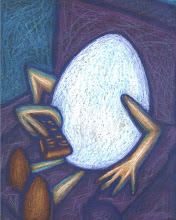Shangri-La

This link will take you to the actual artwork for sale:
http://www.ebay.com/itm/252286085747?ssPageName=STRK:MESELX:IT&_trksid=p3984.m1555.l2649
When James Hilton
wrote Lost Horizon he called his mythical city Shangri-La. The name was deliberately close to
another legendary city called Shambala. The legend of Shambala goes way back in mythical history. James cites the location of his fictional city inside the Kunlun Mountains – near Tibet which lies in the heart of where many ancient religions mesh.
I remember
seeing the movie/musical version of the story when I was a child. I loved the
movie and the message it brought to me as a young girl who knew nothing about
eastern religions.
At one time,
this region was a mixing pool of different eastern religions like Jainism,
Buddhism, Hinduism and Taoism.
When the
Mughal empire ruled over India from 1526-1857, they forbid the native religions
of Buddhism and Hinduism to be practiced in the northern regions of India. They
did allow the practice of these religions in the southern regions but for
India’s northern Buddhists and hinds, they had to practice in secrecy.
For many
years, historians believed Shambala was nothing more than a myth. This myth
changed to fact when a cave entrance in the Himalayas was excavated. They found
remains of a lost civilization inside the Himalayas. This would make perfect
sense since caves are sacred places inside the earth that allow practicing
spiritual seekers to feel the earth’s energy all around them.
The
particular spot where Hilton describes the location of Shangri-la, is supposedly
a sacred spot for Taoism. Both of these religions work perfectly for the spiritual
truths introduced in Hilton’s novel. Buddhism focuses on each human’s
responsibility to themselves and Taoism focuses on each human’s responsibility
to nature.
I loved the
concepts I heard in the movie and then later when I read the book. They seemed
so different than what I was hearing every Sunday in the Catholic Church I
attended with my mother. I held onto that movie for a long time. I wasn’t
allowed to study other religions in my youth and yet, like a patient guide,
these concepts were waiting for the day I became an adult and was able to
choose what I wanted to study.
This painting
is based on the inspiration that explodes inside me every time I hear or read the
word Shangri-La.

